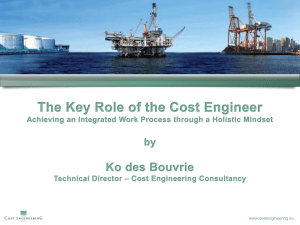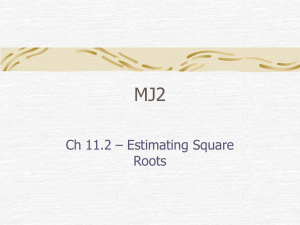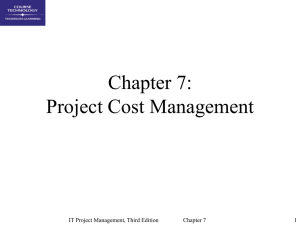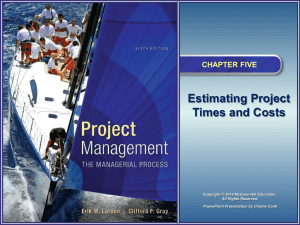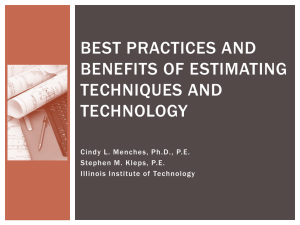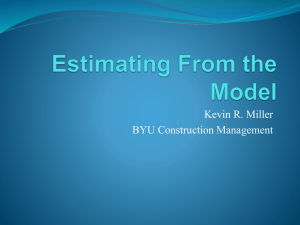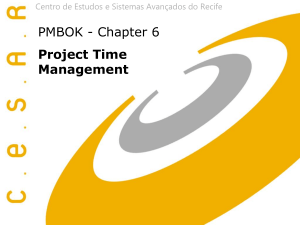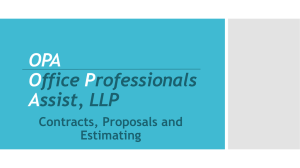GAO Cost Estimating and Assessment Guide
advertisement
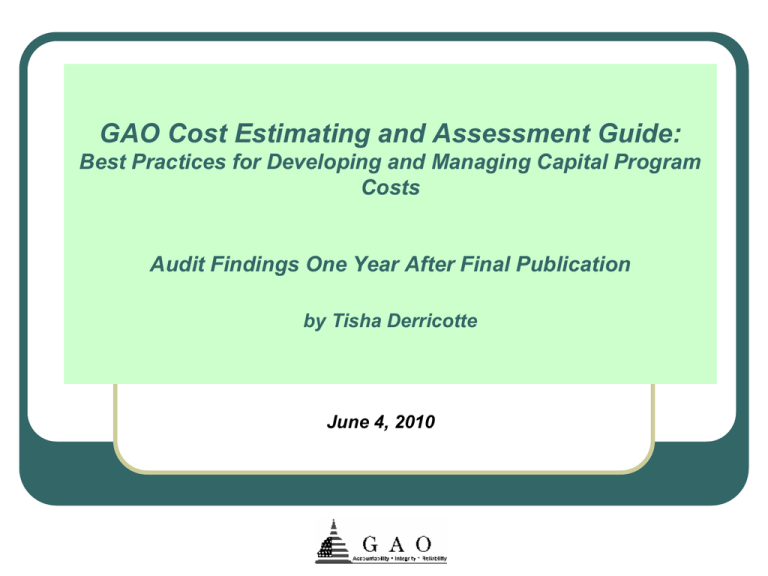
GAO Cost Estimating and Assessment Guide: Best Practices for Developing and Managing Capital Program Costs Audit Findings One Year After Final Publication by Tisha Derricotte June 4, 2010 Why is the GAO Cost Assessment Guide important? GAO assists Congress in its oversight of the federal government including agencies’ stewardship of public funds • • Legislators, government officials, and the public want to know • • Whether government programs are achieving their goals What these programs are expected to cost Developing reliable program cost estimates is critical to • • • Effectively using public funds Meeting OMB’s capital programming process Avoiding cost overruns, missed deadlines, and performance shortfalls • Many of our program assessments find that unreliable estimates are the cause We developed this Guide to • Establish a consistent methodology based on best practices that can be used across the federal government for the development and management of its program cost estimates 2 Why is the GAO Cost Assessment Guide important? (continued) Original intent was to provide auditors with a standardized approach for analyzing program costs • • Our research, however, found federal guidelines to be limited on the processes, procedures, and practices for ensuring credible cost estimates We decided to fill the gap and shifted the intent of the Guide from an auditor’s manual to a best-practice manual Purpose of the Guide is to • • Address best practices for ensuring credible program cost estimates for both government and industry Provide a detailed link between cost estimating and Earned Value Management (EVM) • OMB has endorsed EVM for measuring cost, schedule, and technical performance • Guide demonstrates how realistic cost and schedule estimates are necessary for setting achievable program baselines and managing risk 3 How the Guide Was Developed We developed this Guide in consultation with a “community of experts” from the federal government and industry. • • Together with these experts, we have developed a Guide that • Formal kick-off began at the Society of Cost Estimating and Analysis conference in June 2005 Since then, the community of experts helping to review and comment on the Guide has grown to more than 400 individuals Clearly outlines GAO’s criteria for assessing cost estimates and EVM during audits The Guide can be downloaded for free at: • http://www.gao.gov/products/GAO-09-3SP 4 GAO’s Cost Assessment Guide Layout The Guide consists of 20 chapters with supporting appendices • • Chapters 1-17 address the importance of developing credible cost estimates and discuss in detail a 12 step cost estimating process for developing high quality cost estimates Chapters 18-20 address managing program costs once a contract has been awarded and discuss • • • • EVM Risk management Other program management best practices The Guide also provides case studies of prior GAO audits to showcase typical pitfalls that can occur in the cost estimating process 5 A Reliable Process for Developing Credible Cost Estimates Certain best practices should be followed if credible cost estimates are to be developed. These best practices represent an overall process of established and repeatable methods that, if followed correctly, will result in high-quality cost estimates that are comprehensive, accurate, and easily updated / replicated. 6 Chapter 1: Characteristics of credible cost estimates and a reliable process for creating them This chapter discusses a 1972 GAO report on cost estimating • • We reported that cost estimates were understated and causing unexpected cost growth Many of the factors causing this problem are still relevant today We also discuss a 12 step process for producing high quality cost estimates 7 Chapter 2: Why cost estimates are required for government programs and challenges associated with developing credible results • • Introduces why cost estimates are required for government programs • Developing annual budgets, supporting management decisions about which program to fund, and evaluating resource requirements at key decision points Discusses various challenges associated with developing credible results 8 Chapter 6: The Cost Assessment Team The size of the team is driven by the estimate type • A ROM estimate requires less skill and time than a LCCE Enough time should be allotted for • • Collecting and understanding historical data Clarifying technical program aspects with experts A best practice is centralizing the cost estimating team and process • • • • Facilitates the use of standard processes Results in a strong organizational structure and leadership support Allows for the identification of resident experts Provides for more independence and less bias 9 Chapter 7: Technical Baseline Description The accuracy of the cost estimate depends on the how well the program is defined • In a Technical Baseline, we look for • The system’s purpose, detailed technical and system performance characteristics, work breakdown structure, and legacy systems, if any • Acquisition strategy, quantities, and program schedule A best practice is for this information to be included in a single document The technical baseline should be developed by qualified personnel, preferably system engineers, and approved by the Program Manager The technical baseline should be kept updated with technical, programmatic, and schedule changes 10 Chapter 8: Work Breakdown Structure WBS best practices • • The WBS should be standardized so that cost data can be used for estimating future programs It should be updated as changes occur and the program becomes better defined The WBS should also come with a dictionary that: • • • Defines each element Clearly describes what is and is not included in an element Resources and processes necessary to produce the element 11 Chapter 9: Ground Rules and Assumptions (GR&A) Since cost estimates are based on limited information, they need to be bound by various ground rules and assumptions • Ground rules represent a common set of agreed upon estimating standards that provide guidance and minimize conflicts in definitions • Assumptions are made in the absence of firm ground rules •Assumptions should be sought from experienced technical staff •Assumptions must clearly identify any factors that impact a program’s cost, schedule, or technical status •Solid assumptions are measurable, specific, and validated by historical data Each cost estimate, at a minimum should define the following GR&As: • Program schedule, time phasing, base year, labor rates, and inflation indices • Participating agency support, cost limitations, and government furnished equipment 12 Chapter 10: Data The quality of the data affects the overall credibility of the cost estimate As the foundation of an estimate, data should be: • • • • • • • • Gathered from historical actual cost, schedule, and technical sources Applicable to the program being estimated Analyzed for cost drivers Collected from primary sources (e.g., accounting records), if possible Secondary sources (e.g., cost studies) are next best option, especially for cross-checks Adequately documented Continually collected, protected, and stored in a database for future use Assembled as early as possible, so there is enough time to participate in site visits to better understand the program and question data providers 13 Chapter 11: Developing the Point Estimate To develop the point estimate there are several activities that a cost estimator must accomplish: • • • • • Develop the cost model by estimating each WBS element Express costs in constant year dollars, Sum each of the WBS elements to develop the overall point estimate, Compare the estimate against an independent cost estimate and examine any differences, Update the model as more data becomes available or as changes occur No one methodology is a best practice in all circumstances. • • • • • Analogies should be used early in a program’s life-cycle, when specific information is limited The Build-up method should only be used when an analyst has detailed information Parametrics may be used throughout the acquisition cycle, provided there is a database of sufficient size, quality, and homogeneity to develop valid Cost Estimating Relationships (CERs) and learning curves Expert opinion should only be used very early in the life-cycle, and only when there is simply no other way to derive the estimate Extrapolating from actual cost data yields credible results, but such data is not typically available until the start of production 14 Chapter 14: Cost Risk/Uncertainty Every cost estimate is uncertain due to • • A lack of knowledge about the future Errors resulting from historical data, assumptions, cost estimating equations, and factors analysis Identifies the effect of changing key cost drivers and assumptions all at the same time Risk/Uncertainty Considered a best practice for quantifying the risk around point estimate A point estimate, by itself, is meaningless--Management needs to know • The range of all possible costs • The level of certainty associated in achieving the point estimate in order to make a wise decision • Whether a realistic baseline has been estimated for the program • • An unrealistic baseline has been the cause of many government programs overrunning cost And not delivering promised functionality on time A realistic baseline is critical to a program successfully achieving its objectives As programs mature, the level of confidence increases 15 Chapter 14: Cost Risk/Uncertainty – Example of an S-curve 16 Chapter 15: Validating the Estimate GAO criteria uses a 4 Step Process to validate the data • They are comprehensive, well-documented, accurate, and credible Characteristic Related step Well documented The estimate is thoroughly documented, including source data and significance, clearly detailed calculations and results, and explanations for choosing a particular method or reference. Data have been traced back to the source documentation. A technical baseline description is included. All steps in developing the estimate are documented, so that a cost analyst unfamiliar with the program can recreate it quickly with the same result. All data sources for how the data was normalized are documented. The estimating methodology and rationale used to derive each WBS element’s cost are described in detail. 1. Define the estimate’s purpose 3. Define the program 5. Identify ground rules and assumptions 6. Obtain the data 10. Document the estimate 11. Present estimate to management Comprehensive The estimate’s level of detail ensures that cost elements are neither omitted nor double counted. All cost-influencing ground rules and assumptions are detailed. The WBS is defined and each element is described in a WBS dictionary; a major automated information system program may have only a cost element structure. 2. Develop the estimating plan 4. Determine the estimating approach 17 Chapter 15: Validating the Estimate (continued) Characteristic Related step Accurate The estimate is unbiased, not overly conservative or overly optimistic, and based on an assessment of most likely costs. It has few, if any, mathematical mistakes; those it has are minor. It has been validated for errors like double counting and omitted costs. Cross-checks have been made on cost drivers to see if results are similar. The estimate is timely. It is updated to reflect changes in technical or program assumptions and new phases or milestones. Estimates are replaced with EVM EAC and the Independent EAC from the integrated EVM system. 7. Develop the point estimate and compare it to an independent cost estimate 12. Update the estimate to reflect actual costs and changes Credible Any limitations of the analysis because of uncertainty or biases surrounding data or assumptions are discussed. Major assumptions are varied and other outcomes recomputed to determine how sensitive outcomes are to changes in the assumptions. Risk and uncertainty analysis is performed to determine the level of risk associated with the estimate. An independent cost estimate is developed to determine if other estimating methods produce similar results. 7. Develop the point estimate and compare it to an independent cost estimate 8. Conduct sensitivity analysis 9. Conduct risk and uncertainty analysis 18 Chapter 18: Managing Cost – Planning, 13 steps in the EVM Process 1. Define the scope of effort using a WBS 2. Identify who in the organization will perform the work 3. Schedule the work 4. Estimate the labor and material required to perform the work and authorize the budgets, including management reserve 5. Determine objective measure of earned value 6. Develop the performance measurement baseline 7. Execute the work plan and record all costs 8. Analyze EVM performance data and record variances from the PMB plan 9. Forecast EACs using EVM 10. Conduct an integrated cost-schedule risk analysis 11. Compare EACs from EVM (step 9) with EAC from risk analysis (step 10) 12. Take management action to mitigate risks 13. Update the performance measurement baseline as changes occur 19 Chapter 18: Managing Cost – Planning (cont’d) Benefits of Implementing EVM • • • • • Provides a single management control system that requires work to be broken down to a detailed schedule plan Enhances insight into program performance allowing for problems to be detected early on Promotes management by exception by drawing attention to only the most critical problems Fosters accountability by clearly defining what is expected and when Provides objective information for managing the program and identifying risk 20 Chapter 19: Managing Cost Execution This chapter discusses: • • • • Performing an Integrated Baseline Review to validate the PMB and determine risks Monitoring risks using • A formal risk management plan Performing monthly EVM analysis • Discusses terms and concepts (e.g., BCWS, BCWP, ACWP, CV, SV, CPI, SPI, TCPI, etc., format 5 variance analysis, developing EACs, etc.) Projecting future performance 21 Chapter 20: Managing Cost Updating This chapter addresses: • • • • • Incorporating authorized changes into the PMB, including Engineering Change Proposals (ECPs) Performing continual EVM surveillance to ensure PMB is realistic and reflects current requirements Program Re-baselining Updating the program cost estimate with actual costs Incorporating lessons learned and document reasons for cost and / or schedule variances 22 GAO CAG: Appendices APPENDIX I: APPENDIX II: APPENDIX III: Appendix IV: Appendix V: Appendix VI: Appendix VII: Appendix VIII: Appendix IX: Appendix X: Appendix XI: Appendix XII: Appendix XIII: Appendix XIV: Appendix XV: Appendix XVI: References Auditing Agencies and Their WebSites Case Study Background Information Experts Who Helped Develop This Guide The Federal Budget Process Federal Cost Estimating and EVM Legislation, Regulations, Policies, and Guidance Data Collection Instrument Data Collection Instrument: Rationale Software Engineering Institute (SEI) Checklist Examples of Work Breakdown Structures Schedule Risk Analysis Learning Curve Analysis Technology Readiness Levels (TRLs) EVM-Related Award Fee Criteria Integrated Baseline Review Case Study & Other Supplemental Tools Common Risks to Consider in Software Cost Estimating GAO Contacts and Acknowledgements 23 BACKUP SLIDES 24 Best Practices and Characteristics of a High-Quality Cost Estimate Characteristic Comprehensive Best Practice Step 2: Develop the estimating plan Step 4: Determine the estimating structure Step 5: Identify ground rules and assumptions Well-documented Step 1: Define the estimate’s purpose Step 3: Define the program characteristics Step 5: Identify ground rules and assumptions Step 6: Obtain the data Step 10: Document the estimate Step 11: Present the estimate to management for approval Accurate Step 7: Develop the point estimate and compare it to an independent cost estimate Step 12: Update the estimate to reflect actual costs and changes Credible Step 8: Conduct sensitivity analysis Step 9: Conduct risk and uncertainty analysis Step 7: Develop the point estimate and compare it to an independent cost estimate 25 Characteristics of a Reliable Cost Estimate Comprehensive The cost estimates should include costs of the program over its full life cycle, provide a level of detail appropriate to ensure that cost elements are neither omitted nor double counted, and document all cost-influencing ground rules and assumptions Well-documented The cost estimates should be supported by detailed documentation that describes the purpose of the estimate, the program background and system description, the scope of the estimate, the ground rules and assumptions, all data sources, estimating methodology and rationale, and the results of the risk analysis. Moreover, this information should be captured in such a way that the data used to derive the estimate can be traced back to, and verified against their sources. Accurate The cost estimates should be based on an assessment of most likely costs, and adjusted properly for inflation. Estimates should be grounded in documented assumptions and a historical record of cost estimating and actual experiences on other comparable programs. In addition, the estimates should be updated to reflect any changes. Credible The cost estimates should discuss any limitations of the analysis because of uncertainty, or biases surrounding data or assumptions. Risk and uncertainty analysis should be performed to determine the level of risk associated with the estimate. Further, the estimate’s results should be crosschecked against an independent cost estimate to determine whether other estimating results produce similar results. 26 GAO Findings Related to Cost Estimating A summary of Audit Findings for DHS, DOJ, VA, and DOE High Quality Cost Estimating – How is the government performing? Characteristic Comprehensive Meets Characteristic? Partially Well-documented Partially Accurate Partially Credible Minimally 28 High Quality Cost Estimating Characteristics – High Level Findings In general, government program office cost estimates: • Do not include all program life cycle costs and do break out costs into sufficient detail • Rarely use standardized product-oriented work breakdown structures with common support elements • Do not reflect historical data and/or risk data, including assessing the risk impacts if major assumptions fail • Do not document the cost estimate to a level that would allow a cost analyst unfamiliar with the program to replicate the results • Do not identify a level of confidence associated with the estimate and the desired contingency cost • Are not reconciled with an independent cost estimate • Are not updated to reflect actual costs and reasons for variances • Conduct limited sensitivity analyses that are usually based on engineering judgment rather than historical data • Are presented to management at too high of a level 29 High Quality Cost Estimating Characteristics – Internal Control Findings We found that many government program offices lack the following internal controls: • They do not have a centralized cost estimating organization that includes experienced and trained cost analysts to develop high quality cost estimates • There is no policy or guidance for developing high quality cost estimates including what steps must be followed, how much time is needed, and how estimates will be updated • There is no infrastructure and/or staff available for collecting and storing historical cost and technical data • There is no independent cost estimating organization that can test whether the cost estimate is accurate and realistic • They do not link cost/schedule variances to risks in the cost uncertainty analysis • They do not update the cost estimate on a regular basis with actual cost data from an Earned Value Management System • • Estimates are not updated to capture the reasons for variances and are not linked to risks identified in the risk register Estimates tend to be updated sporadically to comply with major milestones rather than used as ongoing management tools 30 GAO Findings Related to Schedule Estimating A summary of Audit Findings for DHS, DOD, DOE, United Nations, and Veterans Administration A Reliable Schedule is Necessary for Successful Program Management Developing an integrated schedule is key for managing program performance and is necessary for determining what work remains and the expected cost to complete it. The success of any program, therefore, depends in part on having a reliable schedule of • • • When the program’s set of work activities and milestone events will occur, How long they will take, and How they are related to one another. Among other things, a reliable schedule provides • • • A road map for systematic execution of a program The means by which to gauge progress, and A way to identify / address potential problems and promote accountability. 32 Scheduling Best Practices Identified in the GAO Cost Guide Our research has identified nine best practices associated with developing and maintaining a reliable schedule. 1. Capturing all activities 2. Sequencing all activities 3. Assigning resources to all activities 4. Establishing the duration of all activities 5. Integrating activities horizontally and vertically 6. Establishing the critical path for activities 7. Identifying reasonable float between activities 8. Performing a schedule risk analysis 9. Updating the schedule using logic and durations 33 Scheduling Best Practices – How is the government performing? Best Practice Capturing all activities Meets Best Practice? Mostly Sequencing all activities Partially Assigning resources to all activities Minimally Establishing the duration of activities Mostly Integrating activities horizontally and vertically Mostly Establishing the critical path Partially Identifying float between activities Partially Performing a schedule risk analysis Updating the schedule using logic and durations No Mostly 34 Scheduling Best Practices – High Level Findings In general, government program offices: • Do not set a schedule baseline or track against one • Fail to include all activities in the Integrated Master Schedule (IMS) and do not provide traceability of activities to the statement of work • Do not properly sequence activities using correct logic to ensure the schedule is dynamically networked (e.g., missing relationships – dangling activities) • Overuse lags to force activities to occur on predetermined dates • Include high duration activities that are difficult to objectively status and manage • Appreciate the concept of a critical path—but do not appreciate the consequences of unrealistic float • Overuse constraints—and fail to document their justification for acceptable constraints • Do not consistently status the schedule and record a status/data date • Do not perform schedule risk analysis (SRA) • • SRAs, if performed, are usually conducted by the contractors for their internal use SRAs can help with identifying risks due to path convergence – the more activities preceding a given activity the less probable it will start on time 35 Scheduling Best Practices – Other Observations • Contractor schedules are usually more reliable than government program office schedules • Many contract deliverables require an integrated network schedule • Government program offices typically have a one page IMS developed in PowerPoint • Program offices do not resource-load schedules • When we find resources in a schedule they are usually only at the prime and subcontractor levels • Many government program offices believe that resource loading a schedule is overkill • Government program office integrated master schedules (IMS) usually fail to span the entire program • An IMS should account for the entire program, regardless of how many increments, steps, blocks, contracts, milestones, etc. the program is divided into • Schedules are missing a Start and / or Finish Milestone 36 Scheduling Best Practices – Other Observations • Naming of activities tend to be too general • Causes problems when filtering the schedule to look for missing logic or status issues • • • The schedule is not created using the critical path method (CPM) • • • • Filter identifies 5 “Testing” activities with no way to discern what is unique about each test Activities should be phrased using unique identifiers and should be described using action verbs and nouns • “Install Steel for section XYZ” The schedule cannot be used to conduct Schedule Risk Analysis The schedule cannot be relied on by management to evaluate progress and to make decisions Government schedulers often do not have an adequate understanding of the critical path method Too often the scheduler is held responsible for updating and managing the schedule rather than the program manager 37 GAO Cost Guide Updates Invitation to Participate in Further Updates to the Guide GAO invites interested parties to meet with us and other experts to discuss further updates to the Guide so that it continually reflects best practices • If interested, please e-mail your contact info to: • • • Karen Richey - richeyk@gao.gov Jennifer Echard – echardj@gao.gov Carol Cha – chac@gao.gov 39
